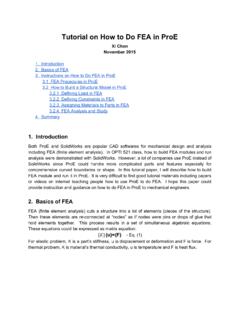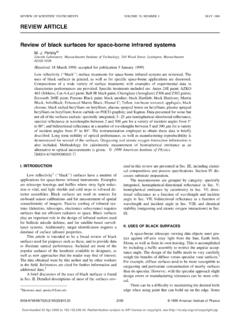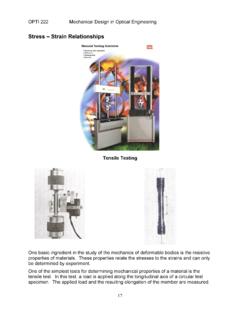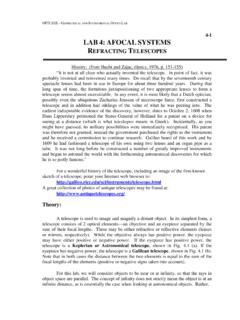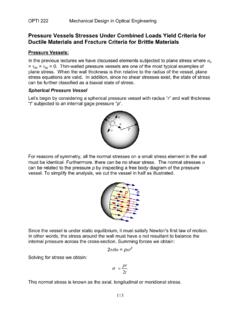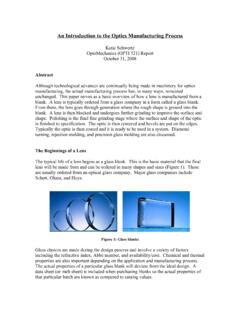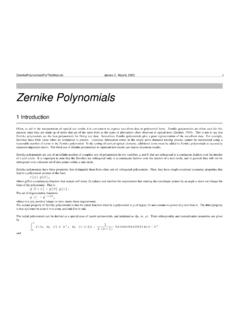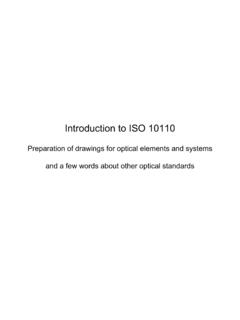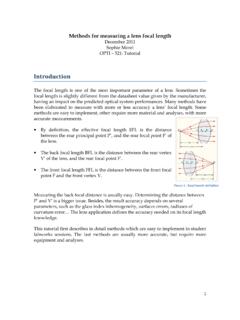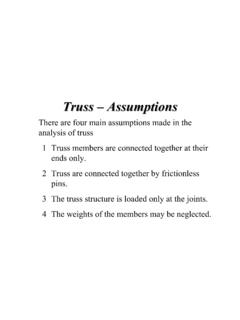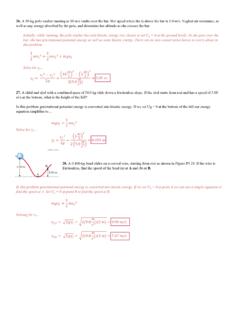Transcription of Statics – no motion
1 University of Arizona J. H. Burge 1 Static equilibrium Static equilibrium Definition: When forces acting on an object which is at rest are balanced, then the object is in a state of static equilibrium . - No translations - No rotations In a state of static equilibrium , the resultant of the forces and moments equals zero. That is, the vector sum of the forces and moments adds to zero. University of Arizona J. H. Burge 2 Tolerances for optics are very tight. We need to support them so they are accurately located. If forces are applied, we want to determine: motion Distortion In order to do this, we need to evaluate the system, including the applied forces and the reaction forces.
2 In this section, we define forces and moments, develop the free body diagram, and use the University of Arizona J. H. Burge 3 equations of static equilibrium to solve for reaction forces and moments. Forces are vectors: They have a magnitude and direction. What does a force do? Can accelerate an object F = m a Can stretch a spring scale Forces can be applied: Units of Pounds on Newtons 1 pound (lbF)= N : 1 N = lb Or they can come for gravity W = m g (g = m/s2 = 386 in/s2) 1 kg has weigh of N or lbs 1 lbM is the mass that weighs 1 pound 1 slug weighs lbs University of Arizona J.
3 H. Burge 4 The moment is defined as Also called torque Units are in-lb or N-m 1 N-m = in-Lb Moments are twisting forces . They make things rotate sinAABBABBABBMrFrFrFrF = == = University of Arizona J. H. Burge 5 Defining moment from applied force A B ABr BF AABBMrF= A B ABr BF A B ABr BF sinABBArFM = A ABr BF ABArFM =sinFF = sinABrr = ArFM = University of Arizona J. H. Burge 6 Force couples Two forces, equal and opposite in direction, which do not act in the same line cause a pure moment d F M = F d F d F M = F d F University of Arizona J.
4 H. Burge 7 Simple cases Cable Can only transmit tension along direction of cable No compression No moment No lateral force University of Arizona J. H. Burge 8 Constraints Constraints are attachment points that will maintain their position. Idealization of 2D supports University of Arizona J. H. Burge 9 Idealization of 3D supports University of Arizona J. H. Burge 10 Free Body Diagrams Step 1. Determine which body or combination of bodies is to be isolated. The body chosen will usually involve one or more of the desired unknown quantities.
5 Step 2. Next, isolate the body or combination of bodies chosen with a diagram that represents its complete external boundaries. Step 3. Represent all forces that act on the isolated body as applied by the removed contacting bodies in their proper positions in the diagram of the isolated body. Do not show the forces that the object exerts on anything else, since these forces do not affect the object itself. Step 4. Indicate the choice of coordinate axes directly on the diagram. Pertinent dimensions may also be represented for convenience.
6 Note, however, that the free-body diagram serves the purpose of focusing accurate attention on the action of the external forces; therefore, the diagram should not be cluttered with excessive information. Force arrows should be clearly distinguished from other arrows to avoid confusion. When these steps are completed a correct free-body diagram will result. Now, the appropriate equations of equilibrium may be utilized to find the proper solution. University of Arizona J. H. Burge 11 University of Arizona J. H. Burge 12 University of Arizona J.
7 H. Burge 13 University of Arizona J. H. Burge 14 University of Arizona J. H. Burge 15 For a rigid body to be static, the net sum of forces and moments acting on it must be zero. 0F= 000xyzFFF=== 0M= 000xyzMMM=== In general six equations, in the plane this reduces to 3 000xyFFM=== University of Arizona J. H. Burge 16 Solving Statics problems Determine reaction forces for static equilibrium . Free Body Diagram Decide if the problem is solvable a.
8 How many unknowns? many equations can you write? equations to sum forces and moments to be 0 a. Use reaction forces as unknowns smart about coordinates and choice of points for summing moments equations for reaction forces your answer and the direction University of Arizona J. H. Burge 17 2D Particle Example Determine magnitude of F2 and F3 University of Arizona J. H. Burge 18 Link Pin joint at both ends equilibrium requires that the forces be equal, opposite and collinear. Therefore, for this member Ay = By = 0 Pin joint will not transmit a moment University of Arizona J.
9 H. Burge 19 Simple Examples Determine reaction forces and moments: Simple support Cantilever a b L B F A F University of Arizona J. H. Burge 20 X and Y components Cantilever L F 45 University of Arizona J. H. Burge 21 Reaction from moments M L F F a University of Arizona J. H. Burge 22 University of Arizona J. H. Burge 23 Example: Hanging a mass, using a pulley 1 kg University of Arizona J. H. Burge 24 2D Pulley Example Specifications: Mass of block A = 22 kg Mass of block B = 34 kg Assumptions: Pulleys are frictionless Block A is free to roll Cable system is continuous Determine: Displacement y for equilibrium University of Arizona J.
10 H. Burge 25 3D Cable System Example Specifications: Weight of plate = 250 lb Assumptions: Plate is homogeneous Determine: Force in each supporting cable Use direction cosines University of Arizona J. H. Burge 26 Overconstraint Each body has a total of 6 degrees of freedom that define its position Such as x, y, z, x, y , z These lead to 6 Equations that can be used to solve for reaction forces: Fx = 0 Fy = 0 Fz = 0 Mx = 0 My = 0 Mz = 0 If the mechanical constraints provide an attachment so that one or more degrees of freedom are free, the body is underconstrained University of Arizona J.
